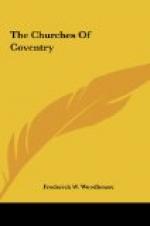The entrance to some wine-cellars in Priory Row gives access to the old pavement level of part of the choir and transept. From the fact that a brick vault forms the roof the cellars have often been looked upon as the crypt of the church but this is erroneous; the vault is a later insertion and if any crypt exists it lies below this level. To the east of the cathedral was the Bishop’s Palace, the gardens of it extending over the detached burial ground of St. Michael’s to the east of Priory Street. The grandeur of this assemblage of buildings grouping, with the spires of the churches behind and rising so magnificently above the houses of the city can best be realized by going to the top of Bishop Street whence may be obtained the finest view of the two spires that remain.
ST. MICHAEL’S CHURCH
[Illustration: St. Michael’s from the north.]
ST. MICHAEL’S CHURCH
CHAPTER I
HISTORY OF THE CHURCH
The early history of St. Michael’s Church is very obscure. The fact that Domesday mentions no parish churches proves nothing. There can be little doubt that one at least existed. Though we have an earlier record of St. Michael’s it is commonly held that Trinity is the elder foundation.
Of St. Michael’s the first notice we have is when Ranulph, Earl of Chester, in the days of Stephen, about 1150, granted the “Chapel” of St. Michael to Laurence, Prior, and the Convent of St. Mary, “being satisfied by the testimony of divers persons, as well Clergy as Laity, that it was their right.” Fourteen dependent chapels in the neighbourhood or within a few miles went with it and the number of these dependencies is held to show that it was “a primitive Saxon parish and of considerable importance.” In 1192 Ranulph Blundeville, grandson of the former Ranulph, gave tithe of his lands and rents in Coventry and bound his officers under pain of a grievous curse to make due payment.
In the early thirteenth century a dispute arose between Bishop Geoffrey de Muschamp and the Priory as to the right of presentation, the Bishop claiming on the ground of being Abbot as well as Bishop. This was settled in 1241 by the Priory renouncing its claim in consideration of receiving a share of the income but in 1248 an exchange was effected, the Priory giving the advowsons of Ryton and Bubbenhall[4] (not far from Coventry) for St. Michael and its chapels and engaging to provide proper secular priests with competent support. In 1260 the church was appropriated to the monastery together with Holy Trinity and its chapels and although in the arrangement of 1248 twenty-four marks (L16) had been assigned to the vicarage, in 1291 we find the priory receiving fifty marks and paying the vicar eight and a half.




